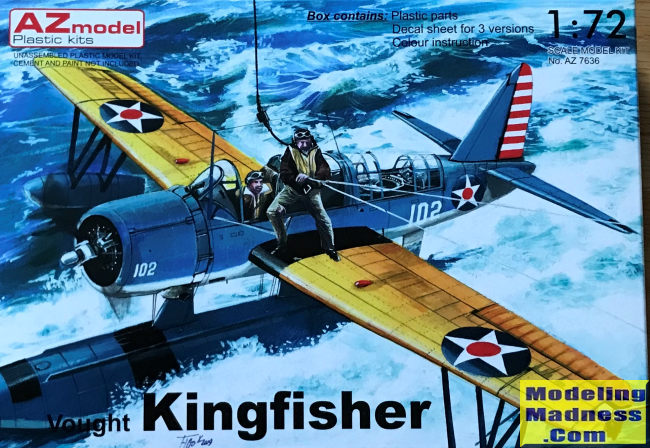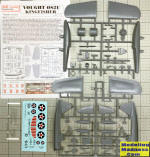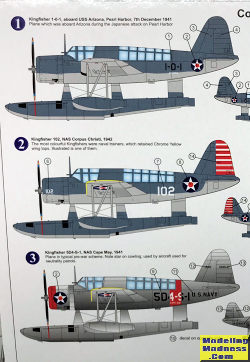
AZ Models 1/72 OS2U Kingfisher
| KIT #: | AZ 7636 |
| PRICE: | $20-30.00 |
| DECALS: | Three options |
| REVIEWER: | Bill Michaels |
| NOTES: | USN Floatplane version |

| HISTORY |
The Vought OS2U Kingfisher was an American catapult-launched observation floatplane. It was a compact mid-wing monoplane, with a large central float and small stabilizing floats. Performance was modest because of its light engine. The OS2U could also operate on fixed, wheeled, taildragger landing gear.
The OS2U was the main shipboard observation aircraft used by the United States Navy during World War II, and 1,519 of the aircraft were built. It served on battleships and cruisers of the US Navy, with the United States Marine Corps in Marine Scouting Squadron Three (VMS-3), with the United States Coast Guard at coastal air stations, at sea with the Fleet Air Arm of the Royal Navy, and with the Soviet Navy. The Royal Australian Air Force also operated a few Kingfishers from shore bases. Kingfishers were also used by training commands as seaplane trainers.
The OS2U first flew on 1 March 1938. Throughout its U.S. Navy service, the OS2U and even its predecessor, the Curtiss SOC Seagull served much longer than planned, as the planned successor, the Curtiss SO3C Seamew, suffered from an insufficiently powerful engine which was a complete failure. The OS2U was only slowly replaced in the latter stages of World War II with the introduction of the Curtiss SC Seahawk, the first examples reaching the U.S. Navy in October 1944.
There were three main versions of the Kingfisher that saw extensive service:
OS2U-1: Initial production variant, powered by a 450 hp Pratt & Whitney R-985-48, 54 built.
OS2U-2: Production variant with minor equipment changes and powered by a 450 hp Pratt & Whitney R-985-50, 158 built.
OS2U-3: Based on the OS2U-2 with self-sealing fuel tanks, armor protection, two .30 cal (7.62 mm) guns (dorsal and nose mounted), and able to carry 325 lb (147 kg) of depth charges or 100 lb (45 kg) bombs, powered by a 450 hp Pratt & Whitney R-985-AN2 engine, 1006 built. (The Naval Aircraft Factory OS2N was the designation of the OS2U-3 aircraft built by the Naval Aircraft Factory in Philadelphia, Pennsylvania.)
| THE KIT |
 This
is a new kit, released at the end of 2019, one of three kits released more or
less together:
This
is a new kit, released at the end of 2019, one of three kits released more or
less together:
Kit AZ7624: OS2U Kingfisher “FAA and USN” (Kingfisher Mk.I). This the landplane (wheeled) version of the Kingfisher. That kit includes decals for two USN and one FAA aircraft. This kit does not appear to include the parts for the floats..(?) This kit includes decals for
US Navy VS-105, NAS Norfolk, 1942.
Fleet Air Arm, East Indies Fleet, 1943.
US Navy, USS Pennsylvania, in pre-war colors.
Kit AZ76 35: Kingfisher Mk 1. This is the floatplane version, and includes decals for one British and two Australian aircraft:
RAAF 1947 (yellow).
RAAF No. 107 Squadron (aluminum)
FAA 765 Squadron, Dorset, 1943.
Kit AZ636: OS2U Kingfisher “US Navy”. This one is the subject of this preview. Markings for three US Navy aircraft are included:
NAS Cape May, 1941, overall light gray.
NAS Corpus Christie, 1942, in yellow and blue trainer colors.
USS Arizona, December 1941, in standard blue-gray over light gray.
According to ScaleMates, the wheeled version of the plane is a “New Tool”, the Kingfisher Mk.I is a “rebox with new parts”, and the USN version is a “rebox with new decals.” It is pretty obvious that all three kits share most of the same plastic. I don't know if the first landplane version of the kit included floats, but the wheeled landing gear parts are on the floatplane kit's sprues. The floatplane also includes the beaching gear parts. Note that the fixed gear of the landplane and the beaching gear use different size wheels-- both are included.
The kit comes in an end-opening box with glossy artwork on the front and the color and markings info on the back. My kit has crisply molded parts with no flash. The parts have nice looking engraved panel lines- maybe not “Eduard state of the art” fine, but equal or better to the nicer Airfix recent releases. (Definitely not “trenches!”) Overall, the kit feels like a great example of how good limited-run kits can be.
The cockpit area has the basics. You get a floor with molded in rudder pedals, a separate bulkhead, seat, instrument panel, and stick. The IP gets a decal to go on the smooth face.
The Observer's position gets a floor, a deck with molded detail, a seat, a scarf ring for the gun mount, with a choice of single or twin .30 cal guns. There is some raised framework detail on the inside of the fuselage at both stations.
The front and rear canopies are molded closed, but they are thin and very clear, with well-defined frames.
The kit's instructions consist of a single A4 sheet of paper folded in half. That's enough room to provide 14 simple steps. Color and markings for all three versions are printed in full color on the bottom of the box. Color call outs use Humbrol numbers and names. The decals look well printed, with good colors and register.
 The
instructions and the markings guide doesn't make an explicit distinction between
OS2U-2 and -3 aircraft. The sprues do include both single and twin .30cal guns
for the Observer, plus optional bombs and racks for the wings, so it looks like
you can build either a -2 or a -3 from the kit. My only unfulfilled wish here is
that the kit only has bombs for underwing stores -- it doesn't include depth
charges.
The
instructions and the markings guide doesn't make an explicit distinction between
OS2U-2 and -3 aircraft. The sprues do include both single and twin .30cal guns
for the Observer, plus optional bombs and racks for the wings, so it looks like
you can build either a -2 or a -3 from the kit. My only unfulfilled wish here is
that the kit only has bombs for underwing stores -- it doesn't include depth
charges.
There was some speculation on the modeling boards that this kit was an update of the Pavla/Ocotpus kit from 2001, with new plastic parts replacing the resin parts. I don't have the Pavla kit, but looking at Scott Van Aken's preview of that kit here on MM, I noticed that the sprue layout on my kit is a lot different than the one he posted. While the Pavla kit was more detailed and accurate than the old Lindberg and Airfix kits, it was described by folks online as being more difficult to build. On example I remember was that the wing to fuselage joint was a butt joint, with no tabs or other alignment aids. This AZ Models kit does have wing mounting tabs on the fuselage-- so that's a nice improvement over the Pavla kit!
| CONCLUSIONS |
Overall, this kit feels like an improved short run kit. It looks to be a better build than the almost 20 year old Pavla kit, and leaves the mis-shapen Lindberg and rivet-covered Airfix kits with their thick, ill-fitting clear parts in the dust. In the box, it looks like this kit is now the best option if you want a Kingfisher in 1/72 scale. I am so happy to finally have a new Kingfisher!
| REFERENCES |
Kit Instructions, Wikipedia, assorted modeling forums.
October 2020
Copyright ModelingMadness.com
If you would like your product reviewed fairly and fairly quickly, please contact the editor or see other details in the Note to Contributors.
Back to the Main Page Back to the Review Index Page Back to the Previews Index Page